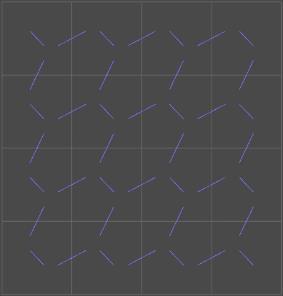cloth & soft body

This node can convert input particle shape into a cloth or soft body. Geometry vertices are converted into particles that are inter-connected with fibers to form a cloth surface. Solid soft body will also connect particles through the geometry interior thus forming a strong supporting structure with options that reduce directional bias. Inflatable soft body creates a different sort of constraints that will try to preserve volume. Both cloth and soft body have plasticity options that control fibers permanent deformation.
|
|
|
|
|
Stretch Fibers |
Shear Fibers |
Bend Fibers |
Note: Fiber tearing is computed by using the Tear node. It provides artists maximum flexibility to control when and where the tear will occur.
[Inputs]
#Particle Stream - This pin requires a particle stream to be connected. Connection is usually not required if any of the attributes is connected. Particle shape will be converted to cloth/soft body.
Enabled - Enable or disable node evaluation.
Fiber Group - Select fiber group for all new fiber connections.
Particle Group - This is the group of particles that will be created at the location of input geometry vertices. If input particle group and output particle group are the same, then the cloth node will skip input particle because such relation will create circular dependency.
Type - Select between cloth, solid soft body and inflatable soft body.
Cloth Properties
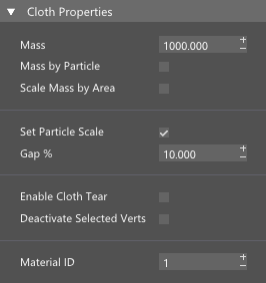
Mass - This will be the mass for the whole cloth, unless the Mass by Particle is enabled.
Mass by Particle - When enabled, the Mass parameter will be the mass of each particle.
Scale Mass by Area - When enabled, the particle mass will be proportional to the triangle area it is adjacent to.
Set Particle Scale - Enable this option if you want particle scale to be set automatically so that no particle overlaps with neighbour particle.
Gap % - Maximum gap between particles.
Enable Cloth Tear - Check this option if you allow cloth tear.
Deactivate Selected Verts - If input mesh has any selected vertices, you can use them as fixed points.
Material ID - Material ID that you want to assign to cloth shape.
Cloth Stretch
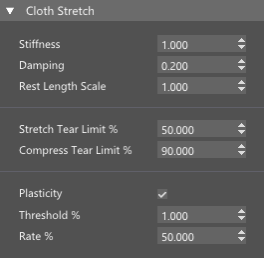
Stiffness - Stretch Fibers stiffness. Stiffer fibers will have higher resistance to stretch forces.
Damping - Use this parameter to dampen fiber`s endpoint velocities. This will only dampen the velocities along the fiber direction.
Rest Length Scale - Use this parameter to change the fiber length when it`s in the rest state. Lower values than 1.0 will have the tendency to shrink the cloth surface as the fiber has the tendency to return to its rest state.
Stretch Tear Limit % - Fiber will be torn if its length increases over this parameter value.
Compress Tear Limit % - Fiber will be torn if its length decreases over this parameter value.
Plasticity - Allow material to accumulate deformations which will then remain permanent.
Threshold % - Stretch threshold after which the material will no longer be able to return to the previous state.
Rate % - The rate at which deformations will accumulate.
Cloth Shear
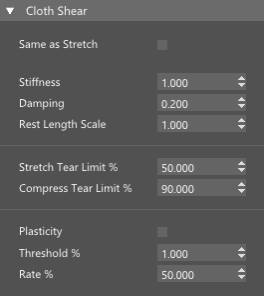
Same as Stretch - When enabled, all shear types of fiber will have the same properties as stretch fibers.
Stiffness - Shear Fibers stiffness. Stiffer fibers will have higher resistance to stretch forces. Stiffness fibers will not be created if this value is set to zero.
Damping - Use this parameter to dampen fiber`s endpoint velocities. This will only dampen the velocities along the fiber direction.
Rest Length Scale - Use this parameter to change the fiber length when it`s in the rest state. Lower values than 1.0 will have the tendency to shrink the cloth surface as the fiber has the tendency to return to its rest state.
Plasticity - Allow material to accumulate deformations which will then remain permanent.
Stretch Tear Limit % - Fiber will be torn if its length increases over this parameter value.
Compress Tear Limit % - Fiber will be torn if its length decreases over this parameter value.
Threshold % - Stretch threshold after which the material will no longer be able to return to the previous state.
Rate % - The rate at which deformations will accumulate.
Cloth Bend
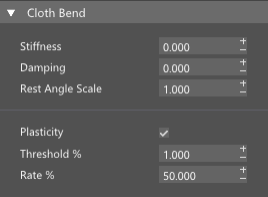
Stiffness - Bend Fibers stiffness. Stiffer fibers will have higher resistance to bending of adjacent faces.
Damping - Use this parameter to dampen the bending effect.
Rest Angle Scale - Use this parameter to change the rest angle between edge`s adjacent faces.
Plasticity - Allow material to accumulate deformations which will then remain permanent.
Threshold % - Bend threshold after which the material will no longer be able to return to the previous state.
Rate % - The rate at which deformations will accumulate.
Solid Soft Body
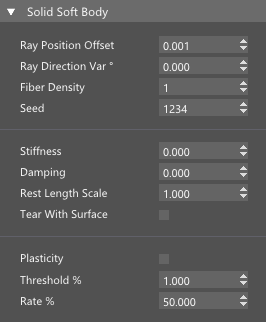
Ray Position Offset - Interior fiber ray position offset. This ray will be used to find a point on the opposite side of the mesh and connect those two points with the Fiber.
Ray Direction Var - Increate this value to create interior fibers in different directions. Useful when Fiber Density is higher than one.
Fiber Density - Amount of interior fibers for each vertex.
Seed - Random number seed for Ray Direction Var.
Stiffness - Interior Fibers stiffness is what prevents the softbody from collapsing.
Damping - Use this parameter to dampen fiber`s endpoint velocities. This will only dampen the velocities along the fiber direction.
Rest Length Scale - Use this parameter to change the fiber length when it`s in the rest state. Lower values than 1.0 will have the tendency to shrink the softbody volume as the fiber has the tendency to return to its rest state.
Tear With Surface - Enable this option if you want to tear interior fibers along with the surface (cloth) fibers.
Plasticity - Allow material to accumulate deformations which will then remain permanent.
Threshold % - Stretch threshold after which the material will no longer be able to return to the previous state.
Rate % - The rate at which deformations will accumulate.
Inflatable Soft Body

Pressure Stiffness - Pressure constraint stiffness is what keeps the inflatable softbody inflated. A value of zero means that softbody is completely deflated and pressure fiber is considered deactivated. You can use Inflate node to inflate object by reactivating those fibers. A value greater than 1.0 will have no effect.
Volume Scale - Use this parameter to change the object volume. Values greater than 1.0 will have the tendency to inflate the softbody beyond its initial volume.
Tear With Surface - Enable this option if you want to tear interior fibers along with the surface (cloth) fibers.
Deflate Rate - As soon as surface Fibers are torn, the deflation of an inflatable Softbody will take place. Use this parameter to control how fast the object will deflate.
Buoyancy - Use this value to determine if inflatable softbody will float in the air.
Plasticity - Allow material to accumulate deformations which will then remain permanent.
Threshold % - Stretch threshold after which the material will no longer be able to return to the previous state.
Rate % - The rate at which deformations will accumulate.
Note: Inflatable softbody can be inflated and deflated by using the Inflate node.
Cloth Aerodynamics
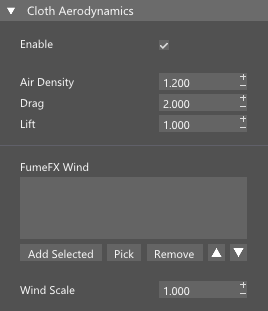
Enable - Enables cloth to react to the wind according to aerodynamics lift and drag forces.
Air Density - Denser air will be able to lift cloth more easily.
Drag - Drag force scale.
Life - Life force scale.
FumeFX Wind - Select FumeFX wind from the scene.
Wind Scale - Wind force scale factor.


